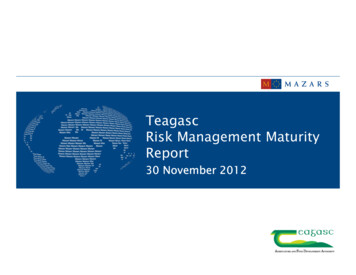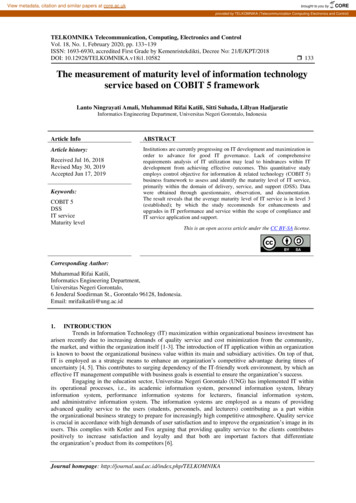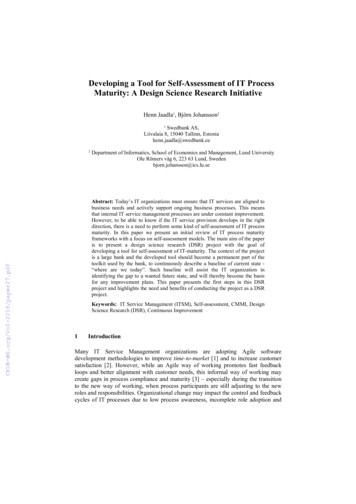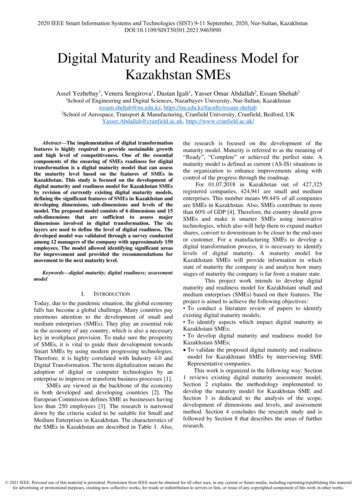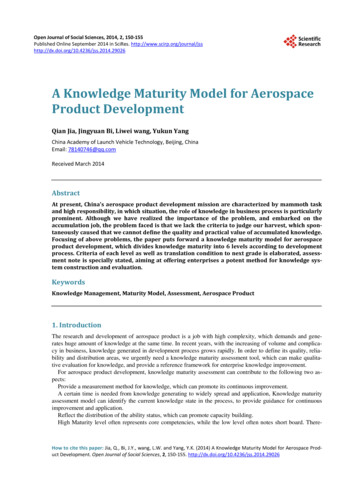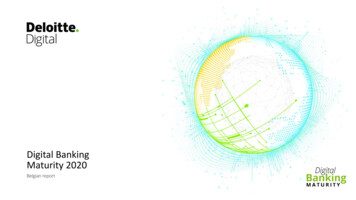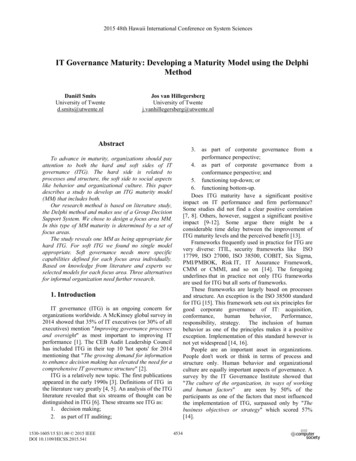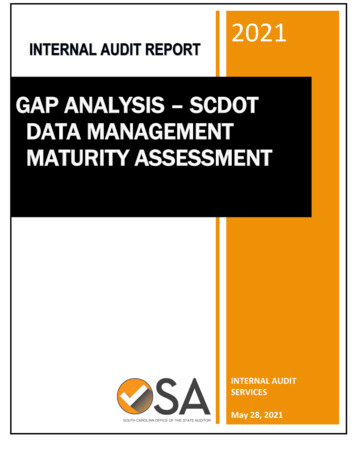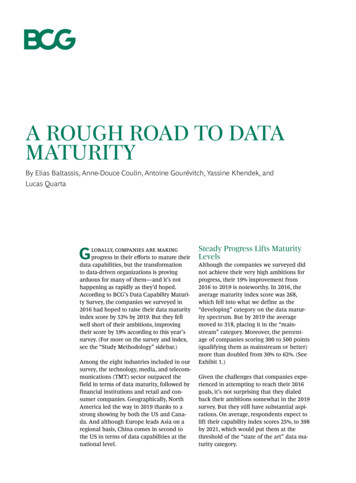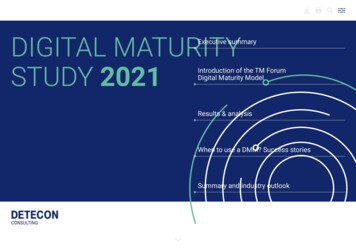
Transcription
DIGITAL MATURITYSTUDY 2021Digital Maturity Study 20211
EditorialDear reader,nological developments in the production of network opera-maturity level of telcos across four different regions –Certainly, there is an infinite number of quotes out there ontors are continuing to gain momentum, forcing telcos toAsia, Europe, Central Africa and South Africa, Middlethe significance and scope of digitalization. Technologicalquickly abandon rigid legacy systems and install soft-East and North Africa.developments and their rapid progress are revolutionizingware-based flexible production mechanisms instead. Toor even completely replacing existing models and pro-master those transformations, increasing efficiency ofThe content is meant to be used as orientation for decisioncesses. Digitalization transforms not only the way wethe core business through smart digitalization and lever-makers as to where other telco providers stand in termswork, produce, communicate, live, but also how we con-aging innovation for new business models is what telcosof digital maturity, and what a possible target level mightsume. This has even been accelerated by the global COV-are striving for.be. It can also serve decision makers in the telco industryto gain insights into prevailing digital maturity levels inID-19 crisis – and especially telecommunications companies feel the increasing digitalization on their networks.Each digital transformation is a seismic shift that organi-their respective markets, and globally. Starting from here,zations make to accelerate change. It has an impact onthe study addresses recommendations and the way for-More than ever before, the telecommunications industrypeople, processes, systems, and organizations. Given theward for actions which are capable of paving new courses.is undergoing profound and far-reaching alterations, char-size, scope and also the time frame of such transformationacterized by completely new competitive structures andactivities, it is advisable to gain a view of the “as-is” digitalWe want to thank every participant in this study very muchfundamental changes in consumer behavior. In the corematurity level of the organization and to set the aspirationalfor their contribution and sincerely hope all readers havebusiness of connectivity, new competitors are appearinglevel for the planned changes.an interesting, and most importantly value-adding, read.on the scene, using innovative technologies and businessmodels. At the same time, the demand for high-quality,The Digital Maturity Model was co-developed by Deteconomnipresent, and secure networking – locally and globally –and the TM Forum and provides a structured and holisticBest regardsis on the rise. Highly reliable connectivity is the basis forapproach to tackling a digital transformation. We are happyBjörn Mendendigital living and working, so it is a crucial factor for theto provide you with the outcomes of our international DigitalManaging Partner & Regional Headfuture competitiveness of national economies. The tech-Maturity Study and to share with you the current digitalMEA, Detecon International GmbHDigital Maturity Study 20212
ExecutivesummaryDigital Maturity Study 20213
Executive summaryExecutive summaryThe main goal of the study was to assess the status quonew technology and the respective departments behindof telecommunications companies’ digital maturity on athem, e.g. IT. On a sub-dimensional level, especially cus-global scale. 30 participating telcos across four regions,tomer trust, strategy management, connectivity & computeAsia, Europe, Central Africa and South Africa (CASA), Mid-Europeand security stood out with high scores.dle East and North Africa (MENA) provided answers to ashortened, online questionnaire of the TM Forum DigitalMENAAsiaMaturity Model (DMM). The questionnaire measures thethe lowest score, indicating that organizations are just start-digital maturity of the organization on a score between oneand five across six dimensions and 25 sub-dimensions.The organization & culture and the data dimension achieveing to realize that the digital transformation is steered byCASAthe people of the organization, and those people need toResults were subsequently analyzed and evaluated on abe enabled through proper organizational structures andglobal as well as a regional scale.cultural measures. The structured gathering, analysis andThe findings show that most telcos reach an “emerging”value-creation from the masses of data that telcos possessFor telco industry members, the study provides answerslevel of digital maturity overall, with a tendency towardsis also still lagging behind, and the vast potential is justto the following questions:“performing”. The MENA region scores the highest,starting to be realized. Strongly in line with that, the sub- What is the general status of digital maturity within telco Europe comes second, followed by Asia and lastly CASA.dimensions customer insight, service design & innovation,providers? What is the digital maturity level of my currenttalent management and data governance achieved theOverall, the participants perform the strongest in the tech- organization compared to that of my regional peers?nology dimension. This can be explained by the core busi- Are there significant outliers among the dimensions?ness of telcos being of a technological nature and in many Are there significant regional differences?cases, digital transformation being steered by the use ofDigital Maturity Study 2021lowest scores in the study.4
Introduction of the TM Forum Digital Maturity ModelDigital Maturity Study 20215
Introduction of the TM Forum Digital Maturity ModelEvery business, despite its size or industry, faces continu-Figure 1: The Digital Maturity Modelous technological advancement with significant disruptivepower that creates great challenges for the organizations. At the same time, opportunities and possibilitiesarise, with promising technologies such as 5G, AI, cloudifi-Close Partnership since 2010cation, and big data. To keep up with the competition, par-Close Partnership since 2010ticularly global technology companies, organizations findthemselves in the difficult situation to decide on where tostart their digital transformation journey.To help organizations navigate through the changing digitalenvironment with ever faster evolving cycles, Deteconhas partnered with the TM Forum to develop the firstindustry- standard Digital Maturity Model (DMM). TheDigital Maturity Study is based on this model, which is anassessment tool that captures an organization’s currentlevel of digital maturity across six business dimensions.The DMM is structured as follows: there are six core business dimensions, namely, Customer, Strategy, Technology,Operations, Organization & Culture, and Data, which capture an organization holistically. These dimensions are further divided into several sub-dimensions that reflect different facets of a digitally mature organization. On the mostdetailed level, each sub-dimension is supported by predefined criteria with unique digital maturity stages throughCustomerCustomerCustomerOutside-In ViewCustomerOutside-InViewCustomer Exp.ManagementCustomer erTrustCustomerTrustTM ForumDevelopment of leadingIndustry StandardsDevelopment of leadingIndustry ologyOperationsMarketing &Brand ManagementMarketing logyOperationsGovernanceGovernanceTechnology & Appli- Service Design &cation ArchitectureInnovationTechnology & Appli- Service Design &cation Architecture ServiceInnovationTransition /SecurityDeploymentService Transition /SecurityDeploymentApplications &ServicePlatformsApplications &Platforms &ConnectivityComputeConnectivity &ComputeCertified partner anddeveloper of DMMCertified partner anddeveloper of DMMOrganization &CultureOrganization anceDataEngineeringDataEngineeringData ValueRealizationData ValueRealizationOperationsServiceOperationsBasis for Digital Maturity StudyBasis for Digital Maturity Studywhich an organization evolves.Digital Maturity Study 20216
Introduction of the TM Forum Digital Maturity ModelFigure 2: Description of Maturity Levelsmaturity level scale from one to five, from initiating (1) to leading (5).Increasing contribution to business gDigital strategy is inearly formulation.Business as usual.Isolated digitaltransformationinitiatives aimedat specificimprovements.35hensive evaluation of the survey results and determinesLeadingheat-maps, to assign priorities to certain areas and start awhat’s the status-quo of organizations on their digital transformation journey. The outcomes can be used to createstructured transformation program. The heatmap showsAdvancingthe gaps between the current and targeted levels of digitalmaturity across the dimensions and sub-dimensions. WithPerformingEffective strategicleadership isdelivering acoordinated andinnovative approach to a digitaltransformation-ledsimplification inmultiple areas ofthe business.After the assessment, the DMM then provides a compre-this positioning of an organization, actions can be derivedDigitaltransformationexcellence isdelivering coherentorganization-widechange andstrategicallycompetitiveadvantage inmultiple areas ofthe business.that enable businesses to create goals and plans, bothBest in class digitaltransformationcapability,optimised for agility,is pervasivelyembedded withinorganizationalculture, processesan trusted partnerecosystems.short and long term or to make impactful transformationproject investments.The DMM can also be used to track progress of a digitaltransformation. Regular assessments make an organization’s change measurable, and success becomes visible.Therefore, organizations can check if they are still on trackof their digital transformation roadmap or if and whereThe model is usually applied as a self-assessment and candegree of digital maturity is assessed by rating eachadditional steering is necessary for a productive and suc-be used to either engage whole organizations, individualsub- dimension criterion. Every criterion has five possible,cessful transformation. This enables organizations todepartments or even individuals across the organization.fully written possibilities of an answer, based on the fivereact early to unwanted deviations or adapt to a changingThe questions are constructed in a way that the prevailingmaturity levels. The participants rate each question on aenvironment.Digital Maturity Study 20217
Results &analysisDigital Maturity Study 20218
Results & analysisKey findingsTelcos’ strategy management hasdigitalization at their coreTelcos enjoy the trust of their customers in delivering on theirbrand promiseWith a score of 3.17, Strategy Management isDigitalization in telcos is technologydrivenTechnology capabilities of the organization areamong the top scoring sub-dimensions of theEuropean telcos are considered especially trust-essential for the delivery of business objectives,entire study. Since the strategy serves as an inte-worthy by their customers, as indicated by a scoreand therefore IT and technology departmentsgral part to guide the path towards an organiza-of 3.02 in the Customer Trust sub-dimension. Indrive the digitalization in telcos. Especially Secu-tion’s vision and mission, telcos have embracedthe face of ever repeating scandals regarding therity scores amongst the top sub-dimensions ofdigitalization as a core guiding principle whenhandling of customer data across the big techthe study with a 3.31. Since telco core businesscrafting new strategic approaches to businesscompanies and hyperscalers, telecommunicationencompasses the operation of critical infrastruc-problems or service expansion. The comparisonoperators – who often have long lasting customerture, this indicates that high priority is placed onto other dimension scores shows that cascadingrelationships – are generally more trusted by theirimplementing security by design in products andof the strategy into day-to-day operations is acustomers and should play on this strength whenservices. Lower scores are observed amongstbigger hurdle than the strategy formulation itself.building their future services and products.technologies regarding applications and platforms, where telcos still struggle to adapt to newertechnologies.Digital Maturity Study 20219
Results & analysisService Design & Innovation in operations requires more agilizationThroughout most telcos, methods such as designLack of formalized data governancehinders the value-adding utilizationof the incredible amount of data thattelcos possessthinking, agile development, continuous servicePro-active Talent Management is required to build and retain the relevantskills for future successPeople are at the core to ensure transformationinnovation etc. only emerge through individual,The value of data-based decision making has longsuccess. Strikingly, Talent Management scoresisolated digital transformation initiatives aimedbeen acknowledged. However, most telcos stillthe weakest in the entire study (2.42). The rapidat specific improvements. Particularly in Europe,conceal their data within silos – which hinders thetechnological changes in the industry constantlythe lowest scoring region with 2.55, this can beoverarching value realization as synergies andrequire new skills and capabilities. Without sus-explained by the fact that the European carriercritical masses of datapoints are not realized.tainable talent management, future businesslandscape consists of many long-establishedAccess to properly formatted and tagged datasuccess is at risk. Therefore, strategic workforcecompanies in the telecommunications industrymodels across different departments is the basisplanning and development is required. Digitalwith rigid structures that need to be overcome onfor all further analysis and engineering and sub-skills are highly in demand in every market, andthe way to a holistically applied agile and digitalsequently, the realization of economic benefit. Tel-telcos struggle to gather the right talent to furtherdelivery model.cos should engage in pushing forward holisticpush into those fields, as technology giants soakdata governance structures, which are currentlyup the key talents with attractive rewards and inno-still lacking, as indicated by the score of 2.48.vative working environments.Digital Maturity Study 202110
Results & analysisResults of the studyFigure 3: Result of each dimensionThe overall scores paint a picture, which in most00cases is to be expected with regards to the devel-112232.82 3only the highest scoring MENA region being anoutlier. This will be further analyzed below in theanalysis part. In the grand total scheme of things,the Technology dimension scores the highest, followed by Strategy and Customer, and subsequentlyOperations, Organization & Culture and Data.across the board, with Customer score of 3.10being the strongest value and Organization ent standards of the regions in question – withThe MENA region achieves the highest results44Grand TotalGrand Total2.67 2.85 2.99 2.84 2.71 2.572.67 2.85 2.99 2.84 2.71 2.572.81 2.92 3.12 2.68 2.78 2.782.81 2.92 3.12 2.68 2.78 2.782.65 2.83 2.86 2.68 2.70 2.712.65 2.83 2.86 2.68 2.70 2.713.09 3.18 3.20 3.05 2.74 2.673.09 3.18 3.20 3.05 2.74 2.67AsiaAsiaEuropeEuropeCASAMENAare markedInteractive graphics(Central Africa, South Africa)(Middle-East North Africa)CASAwith this icon. MENACulture the lowest at 2.71. This is followed byEurope, where according to the grand total average, Technology dominates with a score of 3.12and Organization & Culture and Data are tied forthe last place with a 2.78 each. Asia’s strongestscoring dimension is Technology as well with a2.99, while Data scored comparatively low with a2.57 – the lowest result across the board. In CASAalso, the Technology dimension is on a perform-(Central Africa, South Africa)(Middle-East North Africa)ing level, while the Customer dimension is theweakest in score.Digital Maturity Study nsOperationsOrganization &&CultureOrganizationCultureOrganization & CultureDataDataData11
Results & analysisDeep diveFigure 4: Result of CustomerCustomerThe Customer dimension evaluates the provision of anCustomerengaging experience when customers view the organi-2.672.812.652.823.09zation as their digital partner using their preferred channels of interaction. On the grand total comparison, the customer dimension scores a 2.82 – being on rank 3 of thedimensions. This dimension’s maturity levels are close toCustomerOutside-In View2.662.792.622.932.77reaching the “performing” status, indicating value-addthrough digital maturity across the organization. This underCustomerExperienceMangementlines the fact that digital initiatives in the light of “customer first” and m easured by the Customer Outside-in2.943.072.833.012.98View, Customer Experience Management, Customer Insight and Customer Trust are starting to pick up tractionCustomerInsightwithin telco operators globally. These are perceived toadd value.2.302.452.362.542.96The Customer Outside-in View, which describes the organ-CustomerTrustization’s delivery of a good experience with its productsand services, scores a 2.77 on average and is therefore2.802.942.813.023.56slightly below the average score across all sub-dimensions. Across all regions the sub-dimension underperforms the dimension’s average, indicating that the criteriaGrand TotalAsiaDigital Maturity Study 2021EuropeAsiaEuropeCASACASA (Central Asia South Asia)MENAMENA (Middle East North Africa)12
Results & analysisof the sub-dimension – which describe, amongst others,Customer Insights, with a score of 2.54 is amongst thedata scandals across the big tech companies and hyper-personalization aspects, targeted marketing, self-cus-three lowest rated sub-dimensions across the whole sur-scalers, telecommunication operators – who often havetomization, ease of use and proactive care aspects – arevey. Even with the MENA region strongly outperforminglong lasting customer relationships – are generally morestill on a comparatively low maturity level. Customer con-(3.11) the average customer score, this result shows thattrusted by their customers. This however strongly variesvenience across several channels with relevant customi-data analytic capabilities that create 360-degree views ofbetween the telcos themselves and their intended brandzation and targeted marketing increases in relevancy incustomers, single sources of truths for data as well aspromise. Large, integrated carriers usually experience athe struggle for customers in the telecommunications indus-listening to the voice of the customer are still an area withhigh amount of trust amongst their customers.try. Global technology companies have mastered those fieldssignificant room to improvement before performing andand customers are getting used to those services – telcosadding value across the organization. This is in line withneed to close the gap so as not to frustrate customers withthe data related findings from the respective dimensionnon state-of-the-art treatment.data. Properly assessing, engineering and subsequentlygenerating actual value from customer data is still in theThe sub-dimension Customer Experience Management,early stages, especially in Asia and CASA, and to some ex-across all regions, outperforms the average score of alltent also in Europe. Interestingly, the MENA region rates adimensions as well as the average dimension score forcomparatively strong 2.96, which is in line with our expe-customer with a 2.98. Criteria along the lines of experi-rience of strong focus on utilizing data platforms in theence driven design, customer experience vision, portfolioregion for several years.scope, omnichannel and customer journey managementare therefore in the grand average rated to be performingCustomer Trust is with an overall score of 3.02 an above- in the organizations. As customer experience manage-average strong sub-dimension – across all regions andment, across all channels, as well as the importance ofoutperforming the other sub-dimensions in the Customerwell managed and measured customer journeys is a hotdimension. Criteria such as brand promise, privacy andtopic for projects in the telco industry for several years – thecontrolling of personal information achieve close to per-impact of those measures is clearly reflected by that score.forming scores in most sections. In light of ever repeatingDigital Maturity Study 202113
Results & analysisStrategyFigure 5: Result of StrategyThe Strategy dimension evaluates how well the organizationplans to increase its competitive advantage through a comprehensive digital strategy, and then designs a set of initi-Strategyatives that support the overall business strategy. Overall,2.852.922.832.963.18the dimension is evaluated at 2.96 out of the five levels.The scores for the different sub-dimensions range between2.87 for Ecosystem Management and 3.17 for StrategyMarketing &Brand Management2.752.892.712.91Management. Comparing the score to the overall resultsof the study, the Strategy dimension ranks above the overallaverage of 2.87 and is the second highest dimension after gy dimension. This indicates that digitalizationinitiatives in the Telco industry are generally technologydriven, which is consequently translated into the .47direction of the company.Marketing and Brand Management evaluates if a consistentMarketIntelligence2.892.832.832.93brand message is developed and maintained across allchannels. The score of 2.91 indicates a slightly below average performance in the Strategy dimension, which alsoPortfolioManagement2.642.922.762.89holds true for the regional comparison, with only MENAperforming strongly above average with 3.21. The Marketing and Brand Management covers the brand related topics such as brand strategy, brand governance and 7performance as well as marketing strategy. The scoresindicate that Marketing and Brand Management is onlyDigital Maturity Study 2021Grand TotalAsiaEuropeCASAMENA14
Results & analysisconsidered in some parts of the organization. However,CASA having the lowest score with 2.61. To have dedicatedthis sub-dimension significantly lower than the other regionssince the clear positioning of the brand is essential forbudget readily available and clear processes to retrieve it,with a score of 2.64. Even though Asian economies are in-every business to secure sales, there should be furtheris key for every transformation initiative. Without availablecreasingly innovative in recent years, it appears that thefocus on the improvement in this sub-dimension.funding, the best ideas and intentions cannot be realised,Asian organizations are still less focused on their portfo-and digitalization will stagnate.lio innovation and portfolio roadmap than other regions –Ecosystem Management assesses whether the organiza-at least in the Telco sphere.tion can leverage ecosystems to create business value.The sub-dimension Market Intelligence captures how wellThe overall score for this sub-dimension is 2.87, placingmarket information is gathered to inform the organization’sStrategy Management evaluates if a clear and completethis sub-dimension close to the performing level as well –strategy. Relevant topics in this sub-dimension are for ex-digital strategy is developed and adopted by the organiza-with no significant differences between the regions. Theample the evaluation of the market and customers, as welltions. Key topics here are for example the alignment be-sub-dimension of Ecosystem Management covers topicsas the competitors. With an average score of 2.93, Markettween vision and strategy or the adoption of the digital strat-such as business ecosystems, ecosystem design andIntelligence scores close the performing level. To ensureegy. This sub-dimension received by far the highest overallpartner selection. Ecosystems are essential to securingthe company is well informed and is following the latestscore with 3.17 across all regions. This score places thebusiness in the future. Without the right partners it will beindustry trends and responding to market requirements isStrategy Management sub-dimension well in the perform-difficult for carriers to create, scale, and serve markets inbusiness critical. In line with the comparatively low scoresing stage and among the top scoring sub-dimensions of theways beyond any single organization’s capacity today.in the Data dimension, this result indicates that telcos stillentire model. This score indicates that strategy depart-struggle to create value by utilizing data.ments in telcos have implemented digitalization initiativesFinancial Sponsorship measures whether the necessaryin their strategy. The comparison to other dimension scoresfinancial support is available to support the digital strategy.Portfolio Management assesses if the organization main-shows the cascading of the strategy into day-to-day opera-The topics covered are project funding, investment evalu-tains a balanced portfolio of digital products and servicestions is a bigger hurdle than the strategy formulation itself.ation and investment continuous improvement – thisand scores a 2.89. The topics covered in this sub-dimen-achieved an overall score of 2.97. Looking at the globalsion are among others the portfolio roadmap and the port-distribution of scores, it is noticeable that the best financialfolio innovation. When comparing the global scores, it issponsorship scores are in the MENA region with 3.47, withnoteworthy that especially the Asian respondents ratedDigital Maturity Study 202115
Results & analysisTechnologyFigure 6: Result of TechnologyThe Technology dimension evaluates the technology ca2.993.122.863.20pabilities of the organization to establish, maintain andcontinually transform an environment that supports theTechnology3.06delivery of business objectives. In this study, Technologyis the dimension with the highest grand total score of3.06. The dimension is therefore at a “performing” levelTechnologyGovernanceand is perceived to add value for telcos – across all regions. This is strongly in line with our findings that, espe-2.963.102.993.133.50cially in Europe (3.12) the digital transformation is oftendriven by technology itself and the technology departments behind them. While these scores shed a good3.09Technology &Application Architecture2.863.033.073.19light on telcos’ digital maturity in terms of technology, bybeing far above the other dimensions, it also signals that3.00a holistic digital transformation needs to consider the otherSecuritydimensions as well.Technology Governance with an average score of 3.13covers topics such as technology governance frameworks, the use of industry standards and considerationsApplications rding environmental and energy impact of techno logy. The MENA region achieves a strong score of 3.50 –while the other regions are around the performing mark.Connectivity &Compute3.113.163.112.79Telco operators generally are technology driven, by thenature of their core business. According to the findings,most telcos are therefore already in a position whereDigital Maturity Study 20213.27Grand TotalAsiaAsiaEuropeEuropeCASAMENACASA (Central Asia South Asia)MENA (Middle East North Africa)16
Results & analysisformal governance frameworks are utilized across mostpriority for infrastructure providers and are therefore by noregions. For Europe this is the second strongest sub-dimen-parts of the organization to drive implementation of newsurprise at higher maturity levels. Europe having thesion across the whole survey, as legacy operators adapttechnologies.highest score in this dimension is very much in line withfaster to innovations in regard to their core business, asthe strong regulatory frameworks in place.compared for example to completely new business models.The sub-dimension Technology & Application Architecturereceived a score of 3.03. The use of modern technologiesApplications and Platforms with a score of 2.68 is thealong microservices, Open Source, cloud evolution, openlowest score in the Technology dimension, across all re-APIs, etc. is starting to perform in the telco sphere. Thegions. Criteria that describe big data platforms, artificialMENA region stands out with a 3.19 – showing a compa-intelligence and application development are comparablyrably strong performance. Interestingly, Europe is the lowestlower rated. This is the result of the lack of a priority onscoring and has not reached performing levels yet (2.86).data collection as well as the building up of softwareIn line with findings from the Operations dimension, thecompetencies in the last years by telcos. Those are skillsregional difference can be explained by the prevalence ofhighly in demand in every market, and telcos seem totraditional operators in Europe compared to the MENAstruggle to gather the right talent to further push intoregion, which are usually slower to adapt to new techno-those fields, as tech giants soak up the relevant talent.logical trend. On the flipside, as also large, multi-nationallegacy provider
The Digital Maturity Model was co-developed by Detecon and the TM Forum and provides a structured and holistic approach to tackling a digital transformation. We are happy . Data Governance Data Engineering Data Value Realization Data Basis for Digital Maturity Study Customer Outside-In View Customer Exp. Management Customer Insight Customer Trust

